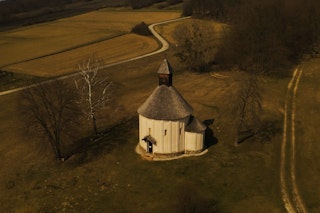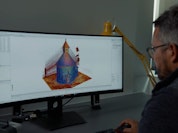Digitization of Rotunda
Cultural heritage preserved for all time
As part of the DIGIKUL project for TIC Moravske Toplice that included the digitization of five immovable cultural heritage properties for the archive of the Ministry of Regional Development and Tourism, we performed a LiDAR capture of the exterior and interior of the Church of St. Nicholas in Selo, the so-called Rotunda.
State-of-the-art technology for one of the oldest buildings in Slovenia
Digitization is the process of transforming information from the physical world into the digital world, providing an excellent basis for the further implementation of digitized heritage for entertainment and educational experiences. The 13th century Romanesque Church of St. Nicholas certainly deserves it, as it is an outstanding monument of the round Romanesque architecture and Gothic frescoes.
The brick building with its conical shingle roof and high-quality interior frescoes has been digitized using state-of-the-art methods. For this purpose, we first carried out a thorough study of the building and then, using a combination of 3D photogrammetry, laser scanning and drone imaging processes, we combined all the materials into a digital format using special software.
How do we preserve our heritage for posterity?
The process of digitizing a building of this kind requires a lot of preparatory work. In addition to a thorough knowledge of the building itself, special attention should be paid to checking material reflectivity, the lighting of the space and the accessibility of the different parts of the building. Only when all these conditions are met, can we do our job well and ensure the right result.
We started the process with 3D digital scanning, which is always the first step and helps us get to a stage called the point cloud. A point cloud is a collection of points in space that are used to create a 3D model. The texture obtained by photogrammetry is then projected onto it and the final optimization is performed. The scanning was complemented by an SLR camera and a drone.
A digital format available to anyone, anytime
The 3D model is designed to display a final form for a specific tourist product. The model of the Rotunda was included in the archive of the Ministry of Economic Development and Technology's digital collection of significant immovable cultural heritage and is available for use as AR in the DIGIKUL application.

1961 done with a camera, 835 with a drone
Transformation into a digital environment
All of the data was backed up
Time spares no one and no thing, least of all our cultural and historical monuments. Through digitization that requires a lot of know-how, we can successfully preserve them for future generations.
